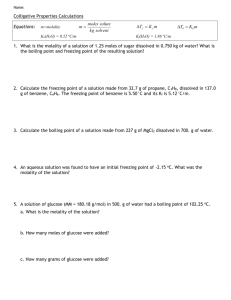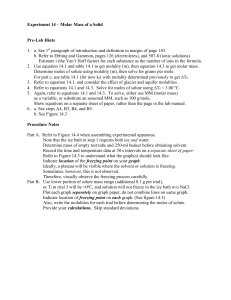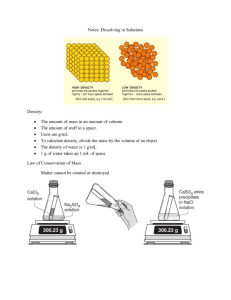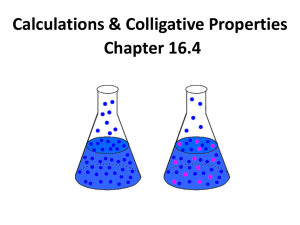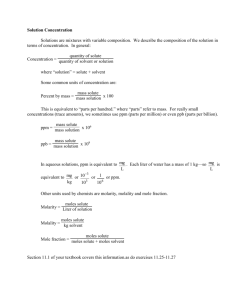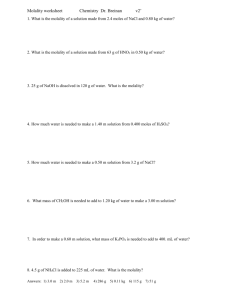Colligative Properties Notes
advertisement
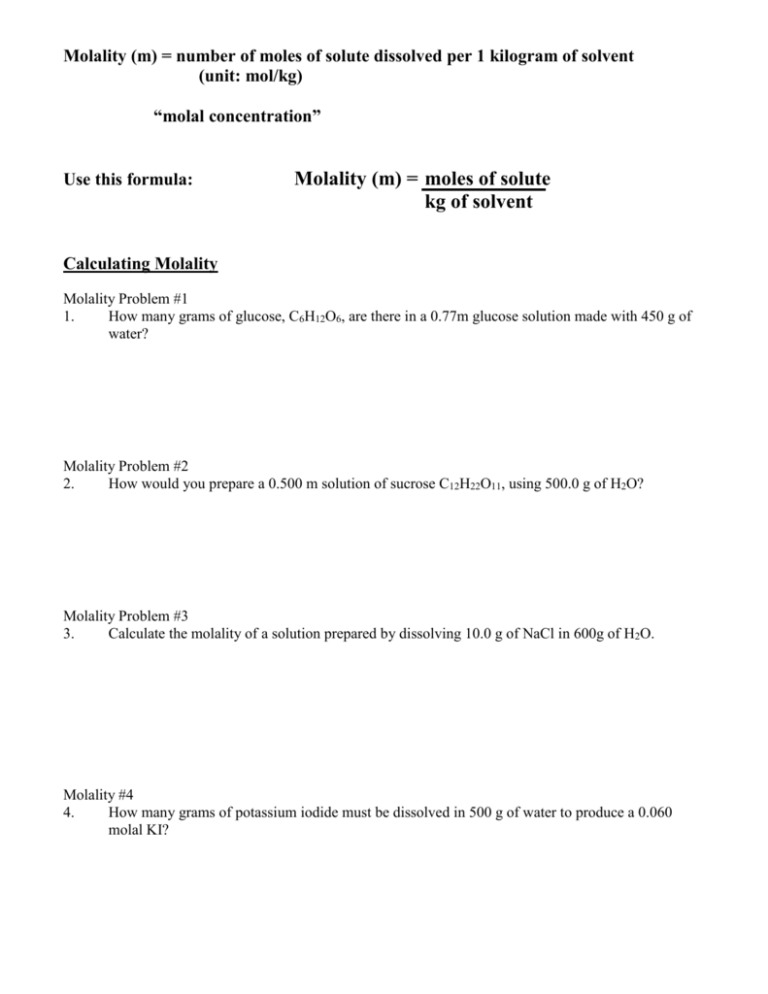
Molality (m) = number of moles of solute dissolved per 1 kilogram of solvent (unit: mol/kg) “molal concentration” Use this formula: Molality (m) = moles of solute kg of solvent Calculating Molality Molality Problem #1 1. How many grams of glucose, C6H12O6, are there in a 0.77m glucose solution made with 450 g of water? Molality Problem #2 2. How would you prepare a 0.500 m solution of sucrose C12H22O11, using 500.0 g of H2O? Molality Problem #3 3. Calculate the molality of a solution prepared by dissolving 10.0 g of NaCl in 600g of H2O. Molality #4 4. How many grams of potassium iodide must be dissolved in 500 g of water to produce a 0.060 molal KI? Colligative Properties of Solutions Physical properties dependent on the number of particles dissolved in a given mass of solvent. - vapor pressure lowering - boiling point elevation - freezing point depression V.P. Lowering – adding a solute to a pure solvent allows attractive forces to form between the solute and solvent, so there are less solvent particles free to vaporize from the solutions. Less particles of vapor creates lower vapor pressure. B.P. Elevation – the difference in temperature between boiling points of a solution and of a pure substance. F.P. Elevation - the difference in temperature between the freezing points of a solution and of the pure solvent. Colligative properties depend on the ratio of the number of solute particles to solvent particles (which is related to the molality of the solution). Calculating Boiling and Freezing Point Changes ∆T = K • i • m ∆T = Temperature change (T final – Tinitial) i = (van’t Hoff factor) the # of particles obtained in the dissolving of solute (for ionic solutes = # of ions in formula; for molecular solutes = 1) m = molality (moles of solute/kg of solvent) K = constant (depends on whether boiling or freezing): Kb = freezing point constant of solvent (for water, use 0.512 m/oC) Kf = freezing point constant of solvent (for water, use -1.86 m/oC) Ionic Compounds dissociate on dissolving, splitting into separate ions. Ions: each polyatomic ion counts as 1 each simple cation = 1 each simple anion = 1 Molecular compounds count as 1 particle (they do not dissociate on dissolving) # Particles of Solutes (van’t Hoff factor) CaCO3 2 NaCl 2 Al2O3 5 MgSO4 2 C12O22H11 1 CaCl2 3 Problem #1 At what temperature will sucrose solution boil if it contains 1.55 moles of sucrose, C12H22O11, in 600 g of H2O? Problem #2 What is the freezing point of 1.40 mol of Na2SO4 in 1750 g of H20? Problem #3 A 1.20 g sample of an unknown covalent compound is dissolved in 50.0g of benzene. The solution freezes at 4.92oC. Calculate the molecular weight of the compound. (Kf for benzene = 5.12oC/m and pure benzene has a freezing point of 5.5 oC) Problem #4 At what temperature will a solution that is composed of 0.73 moles of glucose in 650.0 mL of water begin to boil? Problem #5 What is the lowest freezing temperature for a saltwater solution? The solubility of sodium chloride is 280 g per 1000g of water at 0oC.
